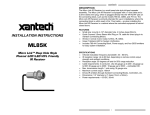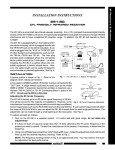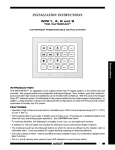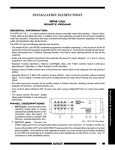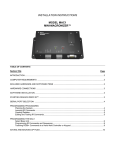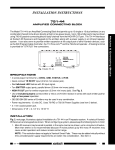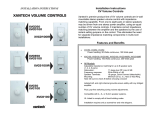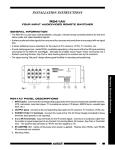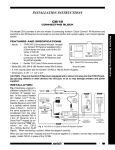Download AMX Sensors and Receivers IR Troubleshooting guide
Transcript
Application Advisory AA-3(IR TS) IR Troubleshooting Guide NOTE: Due to the many variables in a given installation, the troubleshooting countermeasures you will have to take may vary from job to job. Each installation is different due to the number of IR receivers in use, length of wire runs, type of wire, amount of ambient IR noise present, etc…. Therefore, your countermeasures for a particular job will range from nothing at all, to any combination of the solutions listed below. Please Click on the Link below that best describes your symptom: Symptom #1: DIM or NO Talk Back LED during IR Reception or reduced operational range Symptom #2: TB LED on IR Receiver (and/or Emitters) Dimly lit or flickering Symptom #3: TB LED on IR Receiver (and/or Emitters) on solid Symptom #4: TB LED on IR Rec. blinks but 283M or 286M 'Blink' style Emitters do not Symptom #5: Intermittent IR control (I.e. buttons on remote need to be pressed multiple times) Symptom #6: Emitters function but some (or all) components do not respond. Symptom #7: Absolutely No Functionality (How to determine which component is at fault) Model #’s IR Receivers: Model #’s 291, 480, 490, & 780 Series Receivers Symptom #1: DIM or NO Talk Back LED during IR Reception or reduced operational range Cause: Solution 1. Weak Batteries in Transmitting Remote. Replace batteries. 2. Bad Emitter or no emitter plugged into Test emitter and verify wiring. connecting block. 3. Signal wire between IR Receiver and the Recheck wiring. 4. Power Supply not putting out proper voltage. Verify supply is a 12VDC regulated supply reading between 11.5 to 13VDC under load. Should be using Power Supply Model 781RG (12VDC Regulated, 200mA) or 78200 (12VDC Regulated, 1.2A) Connecting Block is open. If you are using a passive connecting block, such as a 789-44, and the system is not working, try the amplified connecting block, Output from the IR receiver/connecting block model 791-44. Put one of the small 5. is connected to a high impedance IR input jack plastic case jumpers supplied with on a component. the block on the pins next to the emitter jack. This will provide the IRin jack on the component with a hotter signal. Page 1 of 7 Application Advisory AA-3(IR TS) Replace Receiver. 6. IR Receiver is inoperable. Need to use a Bypass Kit (model (XTRALINK Only) RF Amplifier is being used BYPASS94 Kit) to route the IR 7. on same COAX Line anywhere between the control signals around the Coupler (CPL94) and Injector (INJ94). amplifier(s). Symptom #2: TB LED on IR Receiver (and/or Emitters) Dimly lit or flickering Cause: Solution Signal and ground wires are reversed or 1. shorted either at the connecting block or IR receiver. 2. Defective emitter. Relatively high levels of ambient noise. This 3. can be due to any of the following: Sunlight, florescent Lighting or Plasma Displays. Recheck your wiring. Replace Emitter In this case use either a SUN filter (SUN480, SUN490, SUN780), or any of our ‘CFL Friendly’ IR Receivers (291-80, 480-80, 780-80). For Plasma Interference use the 490-90 or 780-90 ‘Plasma Friendly’ IR Receivers. These can also be used in direct sunlight and in the presence of ‘tube style’ florescent lighting. Reposition IR Receiver and/or cabling away from emitting device. EMI induced noise. This can be due to light You can also place a 470Ohm dimmer controls or other radiating electronic resistor in parallel with the IR Signal 4. devices (PC’s or any poorly shielded electronic and GND connections on the device). connecting block. This will also help alleviate any stray capacitance in the cable. Use a 490-90 Plasma 'Friendly' IR Receiver. If already using a 490-90 unit, please note the Plasma interference can be reflected off of any item it comes into contact with within approx. 3ft. From the front of the display. Keeping this in mind, make sure that the 490-90 is free from any obstruction that might reflect back into the receiving eye. 5. Plasma Interference Page 2 of 7 Application Advisory AA-3(IR TS) Symptom #3: TB LED on IR Receiver (and/or Emitters) on solid Cause: Solution Use a 490-90 Plasma 'Friendly' Receiver. If already using a 490-90 unit, please note the Plasma interference can be reflected off of any item it comes into contact with within approx. 3ft. From the front of the display. Keeping this in mind, make sure that the 490-90 is free from any obstruction that might reflect back into the receiving eye. 1. Plasma Interference 2. Voltage and Ground wires are reversed at Recheck your wiring. the connecting block or IR Receiver In this case use either a SUN filter (SUN480, SUN490, SUN780), or any of our ‘CFL Friendly’ IR Receivers (291-80, 480-80, 780-80). For Plasma Interference use the 490-90 or 780-90 ‘Plasma Friendly’ IR Receivers. These can also be used in direct sunlight and in the presence of ‘tube style’ florescent lighting. 3. Relatively high levels of ambient noise. This can be due to any of the following: Sunlight, florescent Lighting or Plasma Displays. 4. Reposition IR Receiver and/or cabling away from emitting device. You can also EMI induced noise. This can be due to light place a 470Ohm resistor in parallel with dimmer controls or other radiating electronic the IR Signal and GND connections on devices (PC’s or any poorly shielded the connecting block. This will also help electronic device). alleviate any stray capacitance in the cable. 5. Verify supply is a 12VDC regulated Power Supply not putting out proper voltage. supply reading between 11.5 to 13VDC under load. Page 3 of 7 Application Advisory AA-3(IR TS) Symptom #4: TB LED on IR Rec. blinks but 283M or 286M 'Blink' style Emitters do not Cause: 1. 2. 3 Solution There may be a short, such as a staple Recheck your wiring. driven through the Signal and GND wires of the IR Receiver and/or the emitter. Replace Emitter or use TEST EMITTER Emitter may be shorted internally to check circuit. (XTRALINK Only) TV on same splitter with Place a DC Blocker (Model 203-00) on no IR Receiver installed any TV Leg without IR Receiver Symptom #5: Intermittent IR control (I.e. buttons on remote need to be pressed multiple times) 1. 2. Cause: Plasma Interference Solution Use a 490-90 Plasma 'Friendly' Receiver Relatively high levels of ambient noise. This can be due to any of the following: Sunlight, florescent Lighting or Plasma Displays. In this case use either a SUN filter (SUN480, SUN490, SUN780), or any of our ‘CFL Friendly’ IR Receivers (291-80, 480-80, 780-80). For Plasma Interference use the 490-90 or 780-90 ‘Plasma Friendly’ IR Receivers. These can also be used in direct sunlight and in the presence of ‘tube style’ florescent lighting. Page 4 of 7 Application Advisory AA-3(IR TS) 3. Putting a 470-ohm resistor in parallel at the connecting block between signal and ground will effectively discharge the capacitance of the wire. This will allow the signal to travel farther on shielded wire. Adding a resistor between the input and ground of the connecting block Long Wire Runs – shielded wire typically of will drop the IR level down somewhat. 100 feet (30 meters) or longer causes a filter Passive connecting blocks, such as the effect due to accumulated capacitance of the 789-44, may not have enough signal wire. Intermittent, or no IR control, could output for consistent control of the actually be because of the longer wire runs. equipment. You may have to upgrade to an amplified connecting block to bring the IR level back to normal. In these cases, the 791-44 would be an ideal connecting block for single zone systems while the 795-20 would work best for a 2-4 zone system. Symptom 6: Emitters function but some (or all) components do not respond. 1. 2. Cause: Solution Emitter placement is incorrect. Reposition the Emitter so that it is directly over the components sensor window. Consult the components owners manual of the unit for the exact location of the IR Sensor Window. Reposition the Emitter to a position that is suitable for the unit. Use a 283 or 286M Blink style emitter (they have a lower output than non-blink emitters 282 and 284M). If the components do not Emitter placement is correct but the signal is need to be controlled directly without an IR Repeater system (components are overpowering the unit or there is bleedlocated in an equipment closet), place a through from other emitters close by. Mouse Emitter Shield cover over the Emitter (PN#MS1). The rounded (nonstick) side of the emitter is a hi-output side and can reflect off other devices and overpower some components IR Sensors. If using a CB12 connecting block, try a 789-44 connecting block. This has a series resistor at the output, which will limit current to the Emitter. Page 5 of 7 Application Advisory AA-3(IR TS) 3. Using a CFL-Friendly IR Receiver (291-80, 480-80, or 780-80) and trying to control a unit with a carrier frequency greater then 40kHz (I.e. RCA DSS, Scientific Atlanta, Jerald, and General Instruments Cable or DSS Set Top Boxes). If you are using the 291-80 or 780-80 CFL Friendly receiver, locate the Carrier Frequency Adjustment on the unit and using a small blade screwdriver, (3/32" blade width max.) rotate the adjustment for best performance of all the units in the system. Note: The 480-80 version does not have this feature; you will either need to change the unit to a 291-80, 780-80 or the 490-90. The 490-90 is a wide band unit and will not require any frequency adjustment. Symptom #7: Absolutely No Functionality (How to determine which component is at fault) Step: 1. Component to Test Instructions Verify Power Supply With a Multimeter, measure the DC Voltage of the supply while it is connected to the Connecting Block. Put the Negative lead of the meter on the terminal marked GND and the Positive Lead on the terminal marked 12VDC (or V). You should get a reading between 11.5VDC and 13.0VDC. If not, remove the supply from the Connecting block and measure again this time directly on the 2.5mm Coaxial plug. If it reads between 11.5VDC and 13VDC, power supply is most likely good. Reconnect to the Connecting Block and proceed to step 2. NOTE: In most cases this will indicate the supply is good but in some cases the supply can still be bad (i.e. reads good when not plugged in but may not be able to handle the current load of the system.) Page 6 of 7 Application Advisory AA-3(IR TS) 2. Remove the power supply from the connecting block and all Emitters from the output. Place a jumper wire on the Verify Emitter. (283M or 286M Blink connecting block between IR and +12v. Style ONLY) Reconnect the Power Supply and one emitter. The Emitter should Light bright and solid. Repeat for all emitters. 3. Use a diode tester to verify proper Emitter operation. Remove Emitter from Connecting Block. Place the Positive Lead of the tester on the TIP of the Verify Emitter. (282M or 284M NON Mono Mini Plug and the Negative Lead on the Shield of the Mono Mini Plug. Blink Style) Meter should read a voltage. When the leads are reversed (Positive lead on Shield and Negative lead on TIP) you should not get any voltage reading at all. 4. Remove the power supply from the connecting block and all Emitters from the output. Place a jumper wire on the connecting block between IR Signal and GND. Reconnect the Power Supply. With a known good hand-held remote, shoot a constant IR Command at the receiver and verify the TB LED on the Receiver lights. Verify IR Receiver. Page 7 of 7








